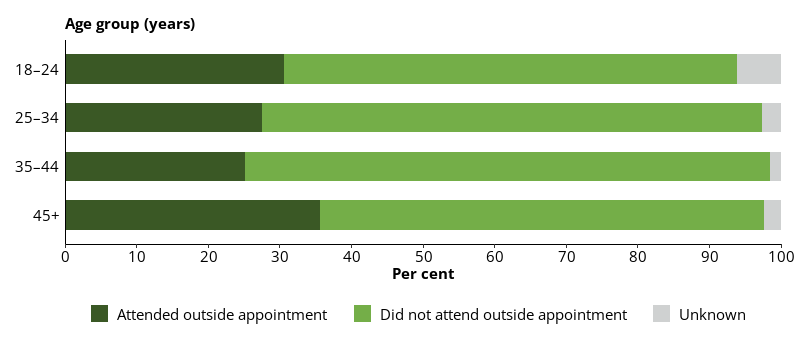Health-care referrals
Transport to a health professional for someone in prison is more problematic than in the community if that health professional is outside the prison. Some consultations require transfer through another prison before attending, and, if having to transfer through a prison perceived as dangerous, people in prison might elect to forego a necessary appointment, rather than go through the transfer process.
Prison entrants’ referral to mental health services
Entrants receive an initial health assessment on entry to prison which is similar to a screening assessment that might include history taking and/or a mental health screening tool (Dean et al. 2017; Martin et al. 2018). The initial health assessment is separate from the NPHDC survey.
After administering the prison entrants survey, clinic staff were asked – after completing the health assessment – if the participant was deemed at risk of self-harm and had been referred to mental health services for observation and/or further assessment. See Mental health and self-harm for further information.
In 4 prisons in New South Wales, researchers administered surveys and did not provide data on this item.
One in 7 (15%) prison entrants were referred to the prison mental health service after their reception assessment (Indicator 3.1.1).
Female prison entrants (28%) were more likely than male prison entrants (13%) to be referred to prison mental health services.
These patterns were generally consistent with prison entrants reporting on their mental health status; that is, female entrants were more likely than male entrants to rate their mental health as poor or fair (see Self-assessed mental health status).
Prison dischargees attending external medical appointments
Prison dischargees were asked whether they had attended a medical appointment outside the prison during their incarceration period.
About 1 in 3 (29%) prison dischargees reported attending a medical appointment outside the prison during their incarceration (Indicator 3.1.2).
Female prison dischargees (38%) were more likely to report attending an outside appointment than male prison dischargees (28%).
Prison dischargees aged 45 and over (36%) were the most likely to report attending a medical appointment outside the prison, and those aged 35–44 were the least likely (25%) (Figure 10.1).
Figure 10.1: Prison dischargees, attendance at a medical appointment outside prison during current prison term, by age, 2022

Notes
- Proportions are representative of this data collection only, and not the entire prison population.
- Excludes Victoria, which did not provide data for this item.
Source: Dischargees form, 2022 NPHDC.
People in custody using community health facilities
In some jurisdictions, people in prison who are hospitalised, or need highly specialised health care, can be managed within the prison system, as larger prisons might contain inpatient beds.
Alternatively, people in custody might be transferred to community facilities or secure wards in community hospitals for specialised treatment. Transfers to hospital might be planned – such as scheduled surgery and specialist outpatient appointments – or unplanned, in emergency situations.
A total of 73 participating prison clinics reported the number of hospital transfers that occurred during the 2-week data collection period.
In 2022, there were 844 hospital transfers in the 2-week collection period (Indicator 3.1.3).
Of the 844 hospital transfers reported by participating clinics in 2022, 31% were acute (or unplanned) transfers to hospital for emergencies, and 70% were non-acute or planned hospital transfers.
People in custody using telehealth
The term ‘telehealth’ is used to describe the delivery of appointments with a health professional via a video or telephone call. Implementing telehealth consultations in correctional settings provides people in prison with greater access to health-care professionals (Tian et al. 2021).
Participating prisons were asked how many telehealth consultations took place during the 2‑week data collection period. A total of 2,038 telehealth consultations took place across 75 prison clinics who provided data for this item.
Dean K and Korobanova D (2017) ‘Brief mental health screening of prison entrants: psychiatric history versus symptom screening for the prediction of in-prison outcomes’, The Journal of Forensic Psychiatry and Psychology, 29(3):455–466, doi:10.1080/14789949.2017.1421247.
Martin MS, Wells GA, Crocker AG, Potter BK and Colman I (2018) ‘Mental health screening, treatment, and institutional incidents: a propensity score matched analysis of long-term outcomes of screening’, International Journal of Forensic Mental Health, 17(2):133–144, doi:10.1080/14999013.2018.1451415.
Tian EJ, Venugopalan S, Kumar S and Beard M (2021) ‘The impacts of and outcomes from telehealth delivered in prisons: a systematic review’, PLoS One, 16(5):e0251840.


